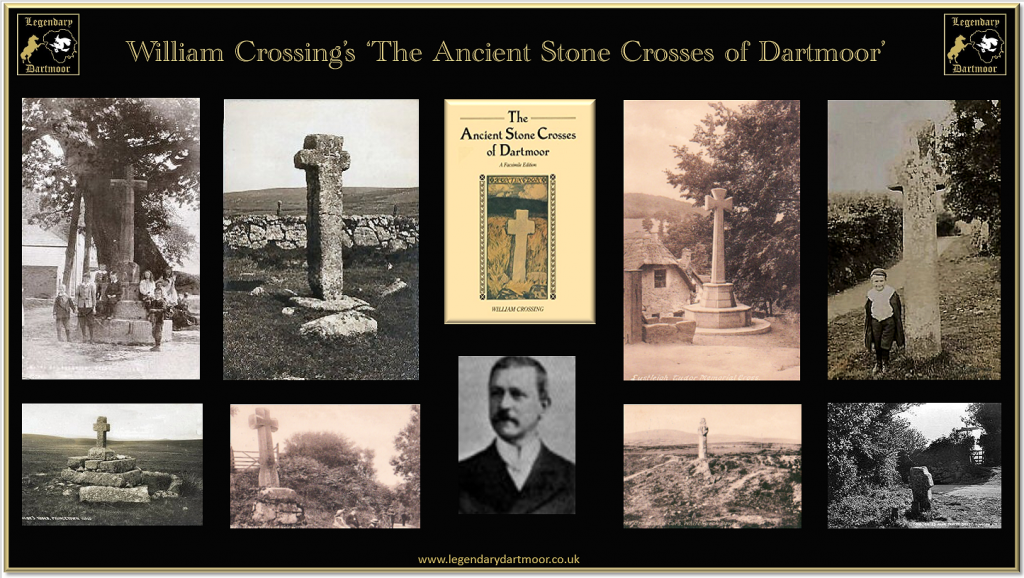
In 1887 William Crossing published his book – ‘The Ancient Stone Crosses of Dartmoor’ prior to which he had spent a great deal of time locating both the standing granite crosses of the moor and those who had not weathered the storms and interventions of mankind and animals so well. He amongst several others were responsible for re-erecting, restoring or both of many of the crosses we can see across the moor today. But why was he so passionate about the old granite crosses? Just about the same time his crosses book was published he gave an interview to the Totnes Times giving a small insight into why, what and how. To this day there is still plenty of interest into these granite relics, one only has to look on Google Images to see a plethora of photographs of many of them. If you would like further proof look no further that the ‘Crossing on Dartmoor’ Facebook Group which has over 1,300 members and is growing weekly. In many cases, as Crossings suggests, they are still used as way-markers and guides to folk crossing the moor. So I’ll now hand you over to Mr. Crossing, speaking some 134 years ago…
“Too often have I discovered an old cross overturned, and all but shrouded from view by the heather springing up around it, its broken shaft and mutilated arms silently upraiding the carelessness which permitted it to remain prostrate in the ground. To chronicle the existence of such as it were previously unknown, and to collect evidence, if such might be discovered, respecting the time and purpose of their erection, as well as those of which mention had been already made by others, has been to me a very pleasant and congenial task; and the happy days spent on the breezy hills of the old moor in my search after these relics, which the companionship I enjoyed rendered happier still, will never be forgotten.
I ventured to put forth a plea on behalf of those old memorials, and ask whether something could not be done to preserve them to us. I pointed out that being links which connected us with past age, we could ill afford to spare them, and that little trouble would be necessary to re-erect such as were fallen, so that the antiquary might no longer be pained at seeing them occupying an ignoble position. This appeal was not made in vain, for the Honorary Secretary (Mr. C. F. Tanner, of Hawson Court, Buckfastleigh) of the Dartmoor Preservation Association was empowered by that body to take steps in this matter, and to this end communicated with me, and inn the summer of 1885 the good work commenced. Ere long, I hope to see the whole of these ancient crosses restored to a condition akin to that in which they originally were, a hope in which I shall be joined by all who are interested in the preservation of our antiquities…
The crosses which are to be found on Dartmoor, like most of our Devonshire examples are of simple form, and cannot boast of the beauty which belongs to some of those existing to the westward of Tamar. A few only possess any ornamentation, and that in a very slight degree; and, with one or two exceptions, no inscriptions are to be seen on them. Their surroundings, however, invest them with charm, particularly their own, for we cannot behold those old lichen-stained and weather-beaten memorials of the past, standing in close proximity to the remains of the habitators of the Celts, without contrasting in our minds the dark times when those huts were peopled, with the clear daylight which beamed forth when the cross was planted, and with the blessing of Christianity has spread over the land. Among the grey tors they stood in solitude – the far stretching heath on every side – with no sound to break the stillness that reigns around but the the rushing of streams from the rugged hillsides. As we gaze upon them, we can let our thoughts stray back to the time when they were first reared, and in fancy may see the wonderous events which have taken place on the stage of this world’s vast theatre.
It is not difficult to determine for what purpose the crosses on Dartmoor were erected. That some were simply boundary marks is certain, and others were very probably set up to point out the direction of ancient tracks. It would seem that their position often indicated the point where two roads crossed, or where one diverged from another; and as these old tracks were in many places nothing more than a grassy path, and in places scarcely to be distinguished, such marks were of the greatest utility, and no doubt often safely guided the traveller, when pursuing his way over the hills of the silent moor.
Mr. Widgery, the well-known landscape artist, has erected on Bra Tor, near Lydford, a cross in commemoration of the jubilee year of the reign of Queen Victoria. Ere long, too, the moor will possess yet another of these objects, for in order to mark a spot on Hameldon, known as Two Crosses, one of the boundary points of the Manor of Dunstone, it is the intention of Mr. Robert Dymond, the well-known archaeologist, to set up a cross there. Having regard to the name of the site, the cross will have two pairs of arms. The restoration of Childe’s Tomb, destroyed early in the present century is also in progress. A new cross will surmount the old monument near Fox Tor.” – The Totnes Times, December 3rd 1887.
 Legendary Dartmoor The many aspects past and present of Dartmoor
Legendary Dartmoor The many aspects past and present of Dartmoor

